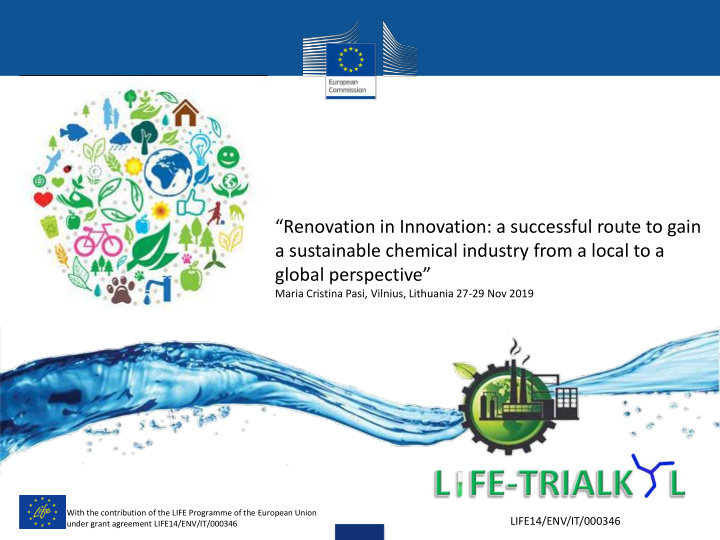



“Renovation in Innovation: a successful route to gain a sustainable chemical industry from a local to a global perspective” Maria Cristina Pasi, Vilnius, Lithuania 27-29 Nov 2019 With the contribution of the LIFE Programme of the European Union LIFE14/ENV/IT/000346 under grant agreement LIFE14/ENV/IT/000346
The five pillars of the circular economy in the chemical industry Circular raw material input Modular design to facilitate regeneration Systemic chemical synthesis platform towards circular outputs Design towards ecosustainable service products New life cycled chemical products
Glocal circular raw material input from local to global ❑ Renewable & sustainable sources (energy – elu-reagents- water cycle) 1-2 2-3 3-1 ❑ Secondary raw materials to reduce environmental impact by ❑ Wastes management reduction ❑ Primary natural sources saving ❑ CO2 emission reduction
Modular design to facilitate regeneration ❑ Stepwise designed synthetic routes aimed at regeneration vs end of life wastes from TMP to TAP through DBHP and TBP ❑ State of the art analysis: scientific literature vs state of the art technologies to discover new BATs ❑ Renovation in Innovation
Systemic chemical synthesis platform towards circular outputs wastes Selective Recycling collection End of life Secondary raw product materials Consumption Systemic Market 1 chemical product synthesis Product 1 Product 2 Trasformation …… Market 2 New cycle
Systemic chemical platform towards circular profitable outputs EV Directly Available Nitrogen fertilizers offer European farmers the highest nitrogen-use efficiency; in addition in order to minimize the Nitrogen concentration in the soil , whose eccess after the harvest causes the eutrophication of the waterways, Ammonium chloride can be used during winter thank to its nitrate slow release by the soil after microorganisms chemical digestion process, making a fruitful balance in the nitrogen concentration in the soil
Chemical design towards ecosustainable service products Chemical design Socio economic impact Environmental impact Glocal policy impact
Chemical design & socio economic impact recommendations Social care chemical product for citizens: SMART Avoidance of harmful chemicals Avoidance of wastes Reduction of emissions (VOCs and PM)
Chemical design & environmental impact recommendations Environmental impacts and risk assessed (full LCA analysis) validation according to LCA ISO standards Quantitative monitoring of key indicators Development of SEIA Analysis of upstream and dowsntream cascade effects
Chemical design & Policy impact recommendations • IED - Industrial Emission Directive pubblished Jan 2011, compliance with the included Integrated Pollution Prevention and Control (IPPC) Directive • BAT - Best Available Technique http://eippcb.jrc.ec.europa.eu/reference/ • BREF – Best available REFerence documents The Industrial Emissions Directive.docx • EWP - The European water policy
New LIFE Cycled chemical products Basic needs -Technical performance -Cost performance - Legal compliance Maintain Stable and safe properties over processing lifetime -Health protection The LIFE cycled -Replicability -Energy saving chemical - Recyclability product -Second life Substances use Systemic process reduction efficiency -No physiological - On line direct KPIs activity detections -Environmental -On line direct removals sustainability
: Renovation in innovation
Thank you all very much for your attention Maria Cristina Pasi - Project coordinator mc.pasi@italmatch.com mc.pasi@izar-enterprise.com and for your contributions! With the contribution of the LIFE Programme of the European Union under grant agreement LIFE14/ENV/IT/000346
Recommend
More recommend